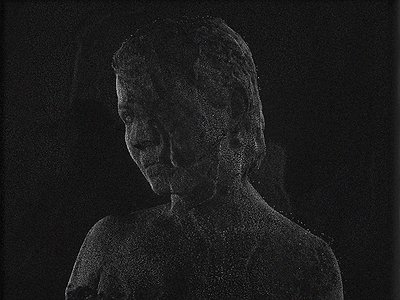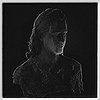Name: Labour
Members: Farahnaz Hatam, Colin Hacklander
Nationality: Iranian, American
Occupation: sound artist, composer and specialist DJ (Hatam), percussionist, drummer and composer (Hacklander)
Current Release: Farahnaz Hatam and Colin Hacklander's first release as Labour, nine-sum sorcery is out now and available through their bandcamp store. They are also featured on the incredible More Light boxset by Berlin Atonal.
Recommendations:
Degrees of Deaf Rage by Christine Sun Kim
Cyclonopedia: Complicity with Anonymous Materials by Reza Negarestani
Sun Pandämonium by Hecker
Persephassa by Iannis Xenakis
If you enjoyed this interview with Labour, the duo have an instagram account which offers more information.
When did you start writing/producing music - and what or who were your early passions and influences? What is about music and/or sound that drew you to it?
Farahnaz Hatam: My route into music is an unusual one; I did not grow up playing an instrument, reading sheet music or learning the basic concepts of western notational music. My initial attempts at creating sound works were in the visual arts context.
In Iran, I grew up listening to female divas in Persian pop music, which at that time in Iran was still allowed: my father would listen to Mahasti, Hayedeh, Googoosh and so on.
My first profound experience of the possibilities of sound as an artistic medium were at avant-garde electronic music concerts at Mills college in the early 90s. A niche group of graduate students in computer music, led by Maryanne Amacher and Alvin Curran, would perform their compositions in weekly sessions that were open to the public. At Mills, I was also introduced to Iannis Xenakis' electronic and instrumental pieces which left a lasting impression on me.
What draws me to sound as a medium is the possibility of the translation of my ideas and thoughts into a monumental yet ephemeral sculptural object in space.
Colin Hacklander: I was raised in a musical household and began writing music at a young age. An early impact of sound must have been my mother playing the organ in a large church, the sound transforming everything around me, including myself.
For most artists, originality is first preceded by a phase of learning and, often, emulating others. What was this like for you? How would you describe your own development as an artist and the transition towards your own voice? What is the the relationship between copying, learning and your own creativity?
Farahnaz Hatam: I like to think that I will never stop learning. The myth of originality is a male construct, one which goes hand-in-hand with the idea of genius and market-driven concepts with capital as their hidden motive. I don't want to feed this idea nor perpetuate it.
"Sometimes we drug ourselves with dreams of new ideas. The head will save us. The brain alone will set us free. But there are no new ideas still waiting in the wings to save us as women, as human. There are only old and forgotten ones, new combinations, extrapolations and recognitions from within ourselves -- along with the renewed courage to try them out." Audre Lorde: "Poetry Is Not a Luxury".
In the visual arts context, my first sound-related works were interactive sound installations and audio for my video works. For my MFA thesis exhibition at Hunter College, I made a work using BigEye, a beta-version software developed at Steim that could detect movement through a connected camera and translate it into MIDI information which then triggered preset sounds in a Yamaha TX81Z FM synth. When I moved to Berlin in 2002 I was no longer satisfied with using samplers, recordings or even synthesisers with preset sounds. I started to learn SuperCollider, a text-based programming environment for algorithmic composition. I do not like easy software based solutions that come out of the box and ease the process of music making; I like to control all aspects of the work down to its minutest detail by building all of my own instruments from scratch through coding.
Through copying we learn how to do something; we figure things out in a technical and pragmatic way. When using software-based solutions for sound generation, one emulates through the use of premade tools based on someone else's thinking which is in turn influenced by past research and investigations in the fields of acoustics, DSP and physics. Ideas are only superficially copyable; one can learn how to sound like someone else but in this case the cohesive glue, which is an own route to the final piece, is missing.
Colin Hacklander: The proliferation and use of sample packs, soft synths, presets and so on, are a natural continuation of the artistic practices of borrowing and collage, yet the readymade aspect of these electronic music making tools are under-acknowledged. I guess originality is most often, though not always, marginal. It comes into being marginally beyond something previously existing.
Perhaps 'emulation' describes a self-consciousness of this process better than 'copying' which is perhaps undertaken more passively.
What were your main compositional- and production-challenges in the beginning and how have they changed over time?
Farahnaz Hatam: Learning a programming language for composition and sound synthesis and understanding the concepts behind Digital Signal Processing. My skills in using SuperCollider are exceedingly better than they were in 2002 and I can do far complexer sound synthesis, etc. However, it is still very challenging for me to play together with instrumentalists especially in situations of improvisation, something I do not often engage in.
Colin Hacklander: The challenge is the same now as it has always been: setting a piece for a specific place and situation. When I was 13 I used to play guitar in a band and we'd open up for rock bands at small bars in Minneapolis earlier in the night. Situational context (mixed with personal musical/artistic interests) gave as much information or energy back then as it does now, even if the venue is a museum in Switzerland, a large concert hall in Australia, or a basement club in Berlin - it's always relational.
What was your first studio like? How and for what reasons has your set-up evolved over the years and what are currently some of the most important pieces of gear for you?
Farahnaz Hatam: I usually work at home on my laptop and nearfield monitors, and have done so since the beginning. At first I was a purist who only used SuperCollider but with time I have added analogue synthesisers to my setup which I control externally with MIDI and SysEx from SuperCollider. I love digital sound; I am not an enthusiast of analogue warmth; when I use analogue synth sounds I treat them through digital effects chains.
Most important pieces of analogue gear are my Genelec nearfield monitors, Buchla modules and Prophet 8.
Colin Hacklander: My earlier studio set-ups focused on instruments and keyboard synthesizers, and there was always a piano. When Farahnaz and I began working together, my interests turned heavily into algorithmic composition and processes that could be modeled using digital compositional tools, at which point the piano, for example, slowly faded as a main tool for thinking through ideas. The drumset remains a key studio piece for me, whether it's being used directly or indirectly, the latter case in which I'm always able to think through compositional ideas while playing drums, even if they have nothing directly to do with the things I am playing at the time.
How do you make use of technology? In terms of the feedback mechanism between technology and creativity, what do humans excel at, what do machines excel at?
LABOUR: Machines are tools. Humans the users. Composing for me happens in the process of working with tools, therefore machines are an essential component to this dialogue.
Often times it seems as though there is a missing self-reflection from electronic musicians; so much is 'ready-made', more than ever before, via the enormous amount of 'end results' so to say on a sonic-aesthetic level via often sophisticated synthesizer presets, plug-ins, and so forth.
Digital electronic music making very much still exists in a state of replication of the preceding technology, so in replication of analog music making technology - whether it's in the tape analogies of 'cutting' and 'looping' or in re-creating the sounds of musical instruments, etc. Even relatively newer digital technologies like granular synthesis are typically employed to serve this mimicry, via implementation in time stretching applications like tempo-changing without changing pitch, etc. Digital technologies like SuperCollider are not set up to pander to such basic notions and understandings of music, and enable the whole future of music to be discovered. SOPHIE is one artist who understood well some of the inherent presumptions of electronic music-making tools in DAWs, plug-ins and so on:
"It seems wacky to me that most DAW software is still designed around having drums/bass/keyboard/vocal presets for production. That's what I find liberating about the Monomachine. It's just waveforms that can be pushed into shapes and materials and sequenced. Just like a sculpture machine. Not like a computer pretending to be a band from the 70's or whatever."
Production tools, from instruments to complex software environments, contribute to the compositional process. How does this manifest itself in your work? Can you describe the co-authorship between yourself and your tools?
Farahnaz Hatam: For example in our piece nine-sum sorcery, I used my own granular synthesis ‘instrument’, that applies various techniques on short fragments of Hani Mojtahedy's voice, utilising cloud formations, algorithmic composition, stochastic distributions and weighted randoms to sculpt the various processes and timings of sonic events.
This application of granular synthesis was chosen to link conceptually to the dust and particles of the desert of the Xerodome, a conceptual inspiration from Reza Negarestani's theory-fiction work, Cyclonopedia: complicity with anonymous materials.
Colin Hacklander: Following from Farahnaz, on the macro compositional level, the drumming section immediately preceding the final section of nine-sum sorcery reinforces the musical idea of stochastic distribution, here as shifting densities, via a non-grid-time approach to rhythm that still follows a precise cyclical notion of time; this is one example of digital sound modeling methods inspiring and enabling the creation of complex processes to be realised on an acoustic instrument like drums.



